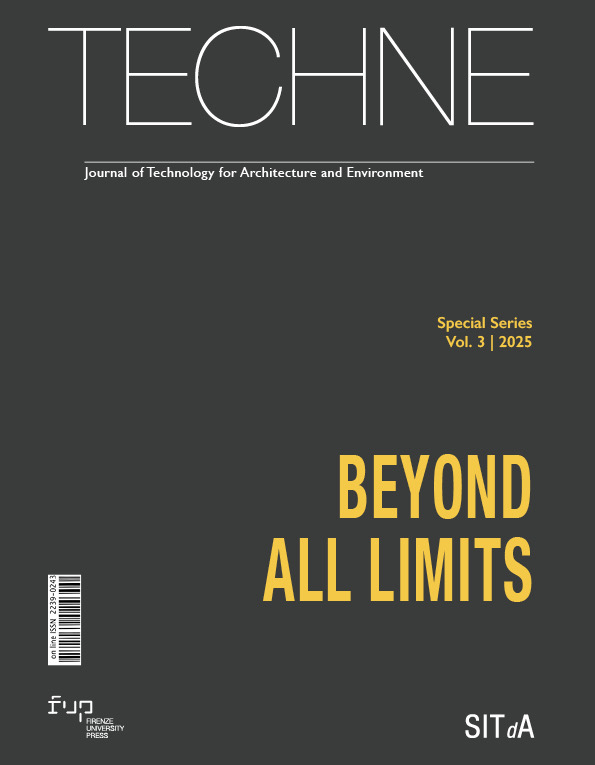Circular & sustainable adaptive reuse of fragile industrial heritage sites. Regenerating Ex SITOCO
Published 2025-07-31
Keywords
- Industrial heritage,
- Circularity,
- Material stock,
- Adaptive reuse,
- Resilience
How to Cite
Copyright (c) 2025 Serena Baiani, Paola Altamura

This work is licensed under a Creative Commons Attribution 4.0 International License.
Abstract
In the fluid design boundaries of technological culture engaging with heritage-urban mine, resilient resource-the research explores innovative experimentation in disused industrial sites in fragile areas. Through environmental design and a lifecycle perspective, it proposes balanced landscape integrations aligned with evolving social, economic, and environmental needs, while addressing multiple risks. The research prioritises control actions on biophysical and morphological components, adopting a circular regeneration approach to reduce the embodied and operational energy of buildings, activating passive functioning to support an “ecologically resilient” transition. The operational, replicable, multi-scale methodology was tested in various pilot cases, exemplified in this paper by the Ex SITOCO site in the Orbetello lagoon.
Downloads
References
- Aytac, D. O., Arslan, T. V., & Durak, S. (2016). Adaptive Reuse as A Strategy Toward Urban Resilience. European Journal of Sustainable Development, 5(4), 523-532. DOI: https://doi.org/10.14207/ejsd.2016.v5n4p523
- Baiani, S., Altamura, P. and Rossini, G. (2023), “Il rovesciamento della piramide – Superiuso dei Termovalorizzatori di Colleferro | The reverse Pyramid – Superuse of Colleferro Incinerators”, in Baratta, A. F. L., Calcagnini, L. and Magarò, A. (eds), Atti del V Convegno Internazionale Recycling | Proceeding of the 5th International Conference Recycling, Anteferma, Edizioni, Conegliano (TV), pp. 132-145.
- Baiani, S., Altamura, P., Turchetti, G. and Romano, G. (2024a), “Energy and circular transition of the industrial heritage – The Ex SNIA case in Rome”, AGATHÓN | International Journal of Architecture, Art and Design, 15, pp. 190–203. Available at: https://doi.org/10.19229/2464-9309/15152024 (Accessed 28/11/2024)
- Baiani, S., Turchetti, G., Romano, G. (2024b), “Widespread Industrial Heritage in Fragile Sites as a Resilient Resource: A Life Cycle and NetZero Approach to Regeneration”, in Battisti, A., Baiani, S. (eds), ETHICS: Endorse Technologies for Heritage Innovation. Designing Environments, Springer, Cham. Available at: https://doi.org/10.1007/978-3-031-50121-0_15 (Accessed 28/11/2024) DOI: https://doi.org/10.1007/978-3-031-50121-0_15
- Braungart, M., McDonough, W. (2002), Cradle to Cradle: Remaking the Way We Make Things, North Point Press, New York.
- Comune di Orbetello (2012), Regolamento Urbanistico – NTA, art. 56: Regole per i tessuti storici, pp.94-95.
- Della Spina, L., Carbonara, S., Stefano, D., Viglianisi, A. (2023), Circular Evaluation for Ranking Adaptive Reuse Strategies for Abandoned Industrial Heritage in Vulnerable Contexts, Building, 13, 458. Available at: https://doi.org/10.3390/buildings13020458 (Accessed 28/11/2024) DOI: https://doi.org/10.3390/buildings13020458
- Eurocities (2020), EU’s Renovation Wave Initiative. Delivered with cities and citizens, policy paper. Available at: https://ec.europa.eu/futurium/en/system/files/ged/eurocities-policy-paper-renovation-wave_final_10092020.pdf
- European Commission (2019), Communication from the Commission to the European Parliament, the Council, the European Economic and Social Committee and the Committee of the Regions ‘A Renovation Wave for Europe – Greening our buildings, creating jobs, improving lives’, document 52020DC0662, 662 final.
- European Commission (2021), Communication from the Commission to the European Parliament, the Council, the European Economic and Social Committee and the Committee of the Regions ‘Fit for 55 – delivering the EU’s 2030 Climate Target on the way to climate neutrality’, document 52021DC0550, 550 final.
- Fu, Y., Hou, M. (2023), “Research on landscape regeneration design of old industrial sites under the concept of sustainable development”, Advances in Engineering Technology Research, ICACTIC 2023, Vol. 6, 677-682. Available at: https://doi.org/10.56028/aetr.6.1.677.2023 (Accessed 28/11/2024) DOI: https://doi.org/10.56028/aetr.6.1.677.2023
- Fusco Girard, L. (2020), “The circular economy in transforming a died heritage site into a living ecosystem, to be managed as a complex adaptive organism”, AESTIMUM 77, Dic. 2020, 145-180.
- Guallart, V. (2014), The self-sufficiency city, Actar, NY.
- ICE, Inventory of carbon and energy database. Available at: http://www.circularecology.com/embodied-energy-and-carbon-footprint-database.html#.VUZxqLlTH4Y.
- Leeuwarden Declaration (2018), Adaptive re-use of the built heritage: preserving and enhancing
- the values of our built heritage for future generations. Available at: https://www.ace-cae.eu/activities/events/2018/built-heritage-conference (Accessed 28/11/2024)
- Pickard, R. (2017), “The Council of Europe and the Industrial Heritage: A UK exemplar of the rehabilitated industrial heritage as a resource for society”, in Ifko, S., Stokin, M. (Eds.), Protection and Reuse of Industrial Heritage: Dilemmas, Problems, Examples, ICOMOS Slovenia, I 02, 9-23.
- TICCIH (The International Committee for the Conservation of the Industrial Heritage) (2003), The Nizhny Tagil Charter for the industrial heritage. Available at: https://www.aipaipatrimonioindustriale.com/_files/ugd/360679_01cf1da0ae0c4b6298f58acd742cf77a.pdf (Accessed 28/11/2024)
- Van de Westerlo, B., Ketelaars, J., & Pereira Roders, A. (2010), “C2C-rehabilitation of industrial heritage, the opportunities for cradle to cradle in the Netherlands”, in Kimman, J. (Ed.), Euregional scientific conference on sustainable building, SB10, 11 – 13 October 2010, Maastricht, the Netherlands, Zuyd University, 1-7.
- Veldpaus L., Olga Krajewska, O., Miah, J., Szemzö, H. (2020), OpenHeritage. Adaptive heritage reuse. Learning from policy and governance frameworks across Europe ICLEI Europe. Available at: https://openheritage.eu/wp-content/uploads/2020/12/Open-Heritage-policy-brief-01-pages.pdf
- Wilson, J. Q., Kelling, G. L. (1982), “Broken Windows. The police and neighborhood safety”, in The Atlantic Monthly Review, 211, pp. 29-38.






